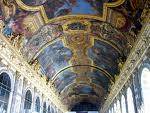The Enlightenment Era
This period in art started with the showing of passion of the French Revolution (18th Century). This era included the Rococo period. Objects were light-hearted and ornate with artistic embellishments.
It represented the aristocracy-the enjoyment of life; to give pleasure to friends. Symmetrical and geometric palaces were built as in Versailles. Man controls his world through reason and intellect. Louis XIV ruled France in an absolute monarchy. Gorgeous palaces and gardens were built throughout France, Italy and Germany. Aristocracy spoke French and followed French customs and dress.
The artist Peter Paul Reubens used circles and elipses to generate action.
Poussin used vertical and horizontal lines in rectangular picture frames.
Galileo invented the telescope and Voltaire was part of the "philosophes" movement that concentrated on the theory of scientists.
There was faith in reason and perfection.
Denis Diderot was the first man to assemble a collection of all of the knowledge at the time-now known as the encyclopedia. He believed that all knowledge is within man's grasp. Common thought then was that perfectability of man was possible through reason. The artist Poussin was an authority of "academism". The ideals of classical antiquity were popular. "The art of the ancients"~the Romans and the Greeks.
Thomas Chippendale furniture
Social and political issues were discussed by the "Philosophes", such as Voltaire, Rousseau and Baron de Montesquieu-who created The Spirit of Laws and introduced the ideals of a govermnment of checks and balances.
Salons and concerts were popular social events, similar to our modern day cocktail parties. Picture Mozart playing piano while Voltaire and Benjamin Franklin discussed philosophy and politics.
Labyrinths were a major theme found in gardens of the Enlightenment Period. It echoed the society's love of intellectual puzzles.
Johann Sebastian Bach wrote "The Musical Offering". 14 units of music all with the same melody~
Americans were influenced by European design. Thomas Jefferson was said to have recieved a stucco model of the Maison Carre and used it as a reference in the building of the Virginia Statehouse.
In 1775 "the shot heard round the world" was heard. The American Revolution was born, ending The Enlightenment Period"











